Abstract
This article demonstrates the possibility of producing alkali-activated materials (AAM) from a mixture of mechanically processed concrete, ceramic, masonry, and mortar wastes, as a sustainable alternative for recycling construction and demolition wastes (CDWs) under real conditions. The addition of 10% Portland cement allowed the materials to cure at room temperature (25 °C). CDW binder achieved a compressive strength of up to 43.9 MPa and it was classified as a general use and low heat of hydration cement according to ASTM C1157. The concrete produced with this cement and the crushed aggregates also from CDW reported a compressive strength of 33.9 MPa at 28 days of curing and it was possible to produce a high-class structural block with 26.1 MPa according to ASTM C90. These results are considered one option in making full use of CDWs as binder and aggregates, using alkaline activation technology thereby meeting the zero-waste objective within the concept of the circular economy.
1. Introduction
Construction and demolition wastes (CDWs) represent a severe environmental pollution problem in most countries, especially underdeveloped ones, due to their inadequate management and low rates of recycling or utilization. Indeed, global CDW generation is alarming, currently representing 25–30% of total solid waste worldwide [1], exceeding the quantity of 3 trillion tons per year [2]. In response to this problem, the “2030 Agenda for Sustainable Development of the United Nations General Assembly”, approved in 2015 by the member countries of the UN, established the “Sustainable Cities” model. Within this model, it is planned to reduce the negative environmental impact of cities by 2030, paying special attention to the management and recycling of generated waste [3]. Sustainable cities are thus required to achieve, through technological innovation, substitution of the “linear economy” for a “circular economy”, in which waste is incorporated (again and again) in the production processes of new products and/or materials (towards the “zero-waste” objective) [4].
In relation to CDWs, these can be classified into two categories: usable and non-usable waste. Non-usable wastes are those that are contaminated with hazardous wastes, so their use is restricted by environmental regulations. Within the group of usable wastes are mainly concrete, ceramic, masonry, and mortar waste. Generally, these wastes have been treated to produce fine and coarse aggregates. These can be incorporated into mortar and concrete mixtures as a replacement (partial or total) for natural aggregates [5], in addition to being used in geotechnical applications, such as the stabilization of slopes, shallow and deep foundations, granular bases and sub-bases [6]. However, the production of recycled aggregates does not represent a solution for exploiting CDWs globally, mainly due to the low commercial competitiveness they possess when comparing their economic (non-environmental) cost with that of natural aggregates in many cities and countries. This disadvantage is compounded by the lack of policies that control the indiscriminate exploitation of natural quarries, aimed at promoting the massive use of recycled aggregates as a replacement for natural aggregates. For this reason, the search for recycling alternatives and/or applications with greater commercial value, which ensure the real use of CDWs, is a priority worldwide.
One of the newest and most promoted solutions for the use of this type of waste is alkaline activation technology or “geopolymerization” [7]. This technology is related with the reaction of a solid aluminosilicate powder (or precursor) with an alkali activator to produce a hardened binder. There are three types of alkali-activated binders: low-calcium alkali-activated aluminosilicate, high- calcium alkali-activated aluminosilicate, and hybrid, which is produced mixing the aluminosilicate precursor with the activator and Portland cement in a proportion lower than 30%. The product of the reaction is a gel whose structure depends on the type of precursor and activator used. Thus, with high-calcium precursors such as granulated blast furnace slag, the main product is a hydrated calcium aluminosilicate gel (C-A-S-H), similar to the gel generated in the hydration of a Portland cement (gel C-S-H), but with lower proportions of CaO/SiO2. In the case of low-calcium precursors such as fly ashes or calcined clays, the gel is an amorphous alkaline aluminosilicate (gel N-A-S-H) of three-dimensional structure.
Using this technology, it is possible to take advantage of most of the aluminosilicate materials that make up the CDW, i.e., concrete, ceramic, masonry, and mortar wastes, as precursors of new cementitious materials, from which it is possible to produce mortars, concrete, and manufacture various structural and non-structural elements (applications of greater commercial value). In this regard, in recent years the International Union of Laboratories and experts in Construction Materials, Systems and Structures (RILEM) and ASTM technical committees were formed to work on research and/or standardization of alkali-activated materials or “geopolymers” with a view to formulating standards that promote their introduction in different fields of application within the construction sector [8].
Regarding the use of CDWs as precursors of alkali-activated materials, the few results published so far, as shown in Table 1 are promising and demonstrate the potential of this type of waste to be reused by this technology. However, these reports are very recent and are limited in most cases to obtaining and characterizing pastes, without scaling these results to the level of their application (mortars, concretes, construction elements, and/or applications). Likewise, in most cases, thermal curing treatments were applied between 50 and 90 °C to achieve adequate mechanical strength, which limits their technological transfer. It should be noted that these studies start from the use of the separated residues, that is to say “clean”, without considering mixtures or combinations between these materials, as can be seen in Table 1.

Table 1.
Articles of alkaline activation of construction and demolition waste (CDW) (database: Scopus/keywords: “alkali activated materials” or “geopolymers” + “construction and demolition wastes”). C.S.: compressive strength (max.), OPC: ordinary Portland cement, MK: metakaolin, FA: fly ash, GBFS: blast furnace slag.
The need to develop and validate applications based on combinations of these residues is evident, that allow an integral use and simulate the real conditions in which the CDWs are found (mixed), especially in those countries with deficiencies in the collection, transport, treatment, and disposal of these wastes, together with monitoring and regulation of the waste management process.
This research demonstrates the possibility of reusing CDW mixtures, as binder and aggregates, in the production of alkali-activated materials. A real CDW sample, taken from a local dump site in Cali (Colombia), consisting of concrete, ceramic, masonry, and mortar wastes, was used as a geopolymer precursor. As an alkaline activator solution, mixtures of hydroxide and sodium silicate were used. The CDW precursor was added with 10% (by weight) of Portland cement (OPC) to promote the curing of the mixtures at room temperature (≈25 °C), thereby obtaining a hybrid cement (CDW binder). Evolution of the heat of hydration and compressive strength of the binder was determined and compared with that of a paste based on 100% OPC. Fine and coarse recycled aggregates were also produced from the CDWs, which were characterized according to the provisions of ASTM standards for use in concrete mixtures. A CDW-based alkaline activated hybrid concrete (AAHC), used as binder and aggregates, was produced and characterized both mechanically and microstructurally, validating from the results obtained the possibility of using alkaline activation technology in obtaining concretes based on high CDW content (binder + aggregates).
Finally, an application of the AAHC was formulated in a precast product—a solid block. The foregoing demonstrated the potential of this concrete in the manufacture of precast materials that meet the specifications and technical standards required for their use and application in the construction sector. It should be noted that this is the first time that results have been reported for alkali-activated materials based on the mixture of concrete, ceramic, masonry, and mortar wastes, in addition to the use of these CDWs in obtaining cement (binder) and aggregates in the same application.
2. Materials and Methods
2.1. Construction and Demolition Wastes (CDW)
The CDW sample was collected locally in Cali, Colombia, and used as raw material (binder and aggregates) for the production of the alkali-activated materials. As seen in Figure 1, the initial CDW sample was composed mainly of concrete, ceramic, masonry, and mortar wastes, and to a lesser extent other usable waste such as: asphalt, wood, metals, polymers, glass, Drywall, paper, and cardboard, all mixed together.
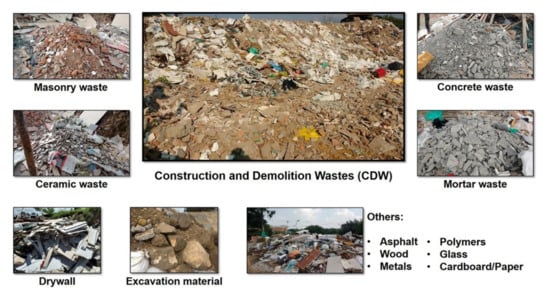
Figure 1.
Actual composition of the sample of CDW utilized in this research. Site for final disposal of waste located in the city of Cali, Colombia.
Concrete, ceramic (red and white), masonry, and mortar wastes were selected and separated from the initial CDW sample in order to be used. In this study, the waste separation process was carried out manually. Figure 2 is a schematic representation of the processes and treatments to which the wastes were subjected to obtain the geopolymeric precursor (CDW precursor) and the aggregates (fine and coarse). The coarse recycled aggregate (CRA) was obtained from the coarse crushing (≤25.4 mm) of the concrete waste, while the fine recycled aggregate (FRA) was produced from the fine crushing (≤4.76 mm) of the ceramic (red and white) and mortar wastes. It should be noted that during these crushing processes (coarse and fine), a considerable amount (≈20% by weight) of powder (particulate material less than 150 µm (sieve # 100)) is generated, a by-product that was collected for each type of waste (concrete, ceramic, and mortar). For its part, the masonry waste was finely ground. The CDW precursor was obtained by mixing the masonry waste and the powders generated in the crushing of the concrete, ceramic, and mortar wastes; each type of material dosed at 25% by weight. Finally, the CDW precursor was subjected to a grinding process in a ball mill in order to guarantee its homogenization and achieve a uniform particle size, as showm in Figure 2.
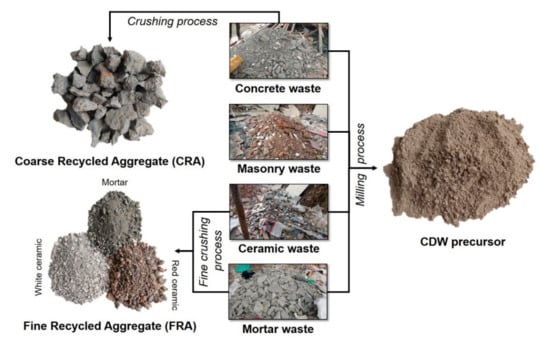
Figure 2.
Obtaining the CDW precursor and recycled aggregates (fine and coarse) from the use of concrete, ceramic, masonry, and mortar wastes.
2.2. Characterization of Raw Materials
The chemical composition of the CDW precursor, determined by X-ray fluorescence (XRF) using a Philips MagiX-Pro PW-2440 spectrometer, is presented in Table 2. The aluminosilicate nature (SiO2 + Al2O3 = 58.8%) of the geopolymeric precursor is highlighted, with a SiO2/Al2O3 molar ratio of 7.2. During the obtaining of the alkali-activated materials, GU type (general use) Portland cement (OPC) was added, the chemical composition of which is included in Table 2. The particle size analysis of the CDW precursor, carried out by means of laser granulometry in a Mastersizer-2000 kit from Malvern Instruments, resulted in a mean particle size D (4; 3) of 92.1 µm, as shown in Figure 3. The mineralogical composition of the CDW precursor was determined by means of X-ray diffraction using a PANalytical X’Pert MRD X-ray diffractometer as shown in Figure 4.

Table 2.
Chemical composition (FRX) of the raw materials (CDW and OPC).
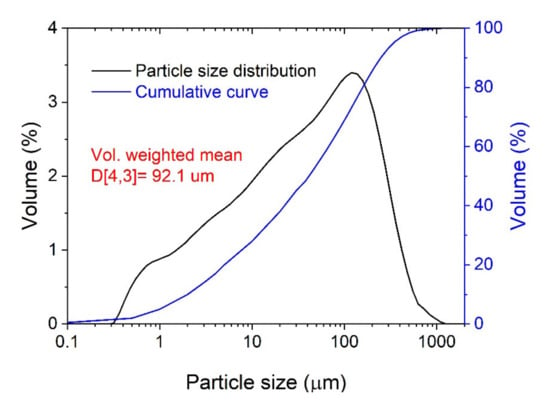
Figure 3.
Particle size distribution of the CDW precursor.
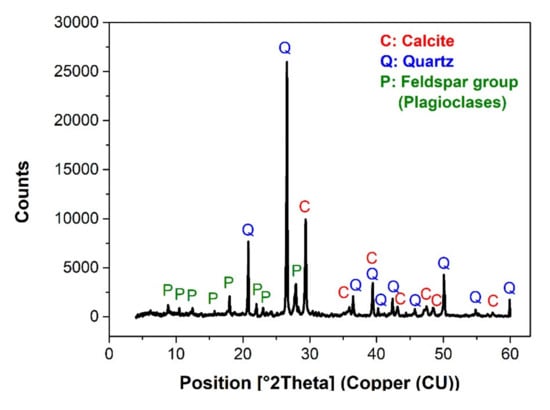
Figure 4.
X-ray diffraction of the CDW precursor.
Figure 4 shows the semi-crystalline nature of the CDW precursor, with quartz (SiO2) (code: 01-083-0539) being the main crystalline phase. Other phases, such as calcite (CaCO3) (code: 01-072-1937) and sodium-calcium feldspars belonging to the plagioclase group (albite-anorthite series) (code: 01-076-0927), were also identified.
As alkaline activator, mixtures of sodium hydroxide (NaOH) and sodium silicate (SS) or “waterglass” (Na2SiO3: SiO2 = 32.09%, Na2O = 11.92%, H2O = 55.99%) were used, both of industrial grade.
2.3. Design of Mixture and Production of Alkali-Activated Materials
The procedure followed to obtain the alkali-activated materials from the CDW is summarized in Figure 5. From the combination of the CDW precursor and a solution composed of the alkaline activator (NaOH + SS) and the mixing water it was possible to obtain an alkali-activated cement. The addition of OPC in small proportions (10% by weight with respect to the precursor as a replacement) made it possible to obtain a hybrid cement (CDW binder), which hardened and developed strengths at room temperature (≈25 °C). From the optimization of this CDW binder, it was possible to produce a CDW mortar and an alkali-activated hybrid concrete (AAHC); in both cases the aggregates developed from the CDW were used.
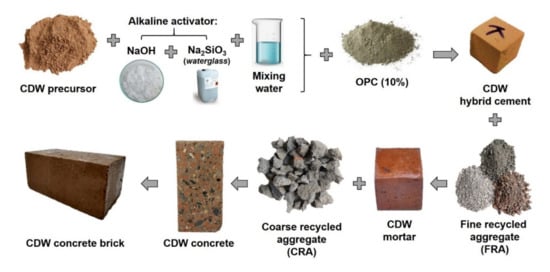
Figure 5.
Schematic summary of the methodology developed to obtain the CDW-based alkali-activated materials.
2.3.1. Binder Optimization
For the optimization of the CDW binder, the effect of the alkaline activator content (weight ratios: (NaOH+SS)/(CDW + OPC) and NaOH/SS) on the compressive strength (7 and 28 days of curing) was evaluated. The pastes were obtained in a Hobart mixer with a total mixing time of 5 min. The liquid/solid ratio (L/S) was 0.25. The fresh pastes were molded into 20 mm cubes on each side and vibrated for 30 s on an electric vibrating table to remove trapped air. Subsequently, the molds were covered with a polyethylene film and remained in the laboratory environment for 24 h. After this time, the specimens were removed from the mold and taken to a final curing chamber (≈25 °C) that ensures a relative humidity (RH) of over 80% until reaching the test age. The optimal setting time of the CDW binder was determined according to the procedure described in ASTM C191 (Method B). The evolution of heat (during alkaline activation) and the total heat of reaction (48 h) were evaluated by means of an I-Cal 8000 isothermal calorimeter. For the calorimetric analysis of the CDW binder, a comparison was made with a 100% OPC-based paste (GU type) and a paste based on the mixture 90%CDW+10%OPC+H2O. Once the alkaline activator content was optimized, the evolution of the compressive strength (1–90 days of curing) was evaluated, using an INSTRON 3369 universal testing machine, which has a capacity of 50 kN force, at a speed of 1 mm/min. For each mix, a minimum of three specimens were tested.
Subsequently, in order to classify the CDW binder according to the specifications of ASTM C1157, the compressive strength was determined at 28 days (≈25 °C) of a mortar produced following the procedure described in the standard ASTM C305. The test specimens were 50.8 mm cubes on each side (ASTM C109).
2.3.2. Characterization of the Recycled Aggregates
Table 3 presents the main characteristics of the fine and coarse recycled aggregates obtained from the CDW sample, which were termed FRA and CRA, respectively. It is highlighted that these aggregates presented high levels of absorption; 12.12% (ASTM C128) for the FRA and 9.17% (ASTM C127) for the case of the CRA. The high absorption capacity of recycled aggregates is directly related to their nature. It should be noted that the recycled aggregates obtained from concrete or mortar waste contain not only the original aggregates but also hydrated cement paste, which increases its porosity and absorption. In addition, the bulk density and unit weight of FRA and CRA presented a lower value compared to that of natural aggregates due to their higher porosity. The maximum CRA size was 25.4 mm (1 in.) and the FRA fineness modulus was 3.04 (coarse sand) (ASTM C136). The resistance to degradation by abrasion and impact evaluated in the “Los Angeles machine” (ASTM C131) was 33.65% for CRA, being possible to use it in the production of concrete mixtures, taking into account this value and those stipulated by ASTM C131. The organic matter content (ASTM C40) of the FRA was the minimum (organic plate No. 1), allowing its use in mortar and/or concrete mixtures.

Table 3.
Characteristics of the recycled aggregates (fine and coarse) obtained from the CDW sample.
2.3.3. Concretes and Blocks: Production and Characterization
The CDW-based AAHC (binder and aggregates) was produced according to the mix design presented in Table 4. The mix design was based on an adaptation of the “absolute volume” method proposed by ACI 211.1. This method requires knowledge of the volumes occupied by all the components of the mixture. For this, the density of each component, including the alkaline activator solution, was determined. The precursor content (500 kg/m3) and the liquid/solid ratio (L/S = 0.37) were set to achieve a design compressive strength (28 days) greater than 28 MPa (4000 psi).

Table 4.
Design of mixtures of alkali-activated hybrid concrete (AAHC) based on CDW.
AAHC was obtained in a CreteAngle horizontal mixer with a mixing time of 8 min. The slump of the mixtures was verified (75–100 mm) according to ASTM C143. The mixture was poured into cylindrical molds (76.2 mm in diameter) and vibrated for 30 s on an electric vibrating table to remove the trapped air. The cylindrical molds were covered for 24 h with a polyethylene film and after this time the cylinders were removed from the mold. The AAHC specimens were cured at room temperature (≈25 °C) and at a relative humidity (RH) greater than 80% until reaching the test age.
The compressive strength of the AAHC was evaluated according to the ASTM C39 standard in a hydraulic press (ELE International) of 1000 kN capacity. Splitting tensile strength was evaluated according to ASTM C496. The microstructural analysis was performed by a scanning electron microscopy (SEM) technique using a JEOL JSM-6490LV microscope with an acceleration voltage of 20 kV. The specimens were evaluated in the low-vacuum mode. An Oxford Instruments Link-Isis X-ray spectrometer was coupled to the microscope (EDS). The samples corresponded to pieces of approximately 1 cm3 extracted from the AAHC (28 days of curing) by means of precision cutting. The samples were encapsulated in epoxy resin and the observation surface was polished.
Finally, from the AAHC, solid concrete blocks were produced which were physically and mechanically characterized according to the provisions of the ASTM C140 standard. In all cases, the data reported in the physical and mechanical tests correspond to the average of three test specimens.
3. Results and Discussion
3.1. Characterization of the CDW-Based Hybrid Cement (Binder)
The effect of the NaOH+SS/CDW+OPC and NaOH/SS ratios on the compressive strength of the CDW binder can be seen in the contour diagrams in Figure 6. The results indicate that the presence of high NaOH+SS/CDW+OPC (>0.35) ratios cause a decrease in compressive strength, both at 7 and 28 days of curing. This indicates that alkaline activator contents (NaOH+SS) above an optimal value affect the mechanical performance of CDW hybrid cement. This effect coincides with that reported by Olivia and Nikraz [22] and Reig et al. [23], who report that the increase in the content of alkaline activator can cause a decrease in compressive strength in this type of system. The NaOH/SS ratio meanwhile did not have a significant effect on compressive strength. In this regard, a horizontal orientation of the contour lines is observed at 28 days of curing, as shown in Figure 6b, which demonstrates the non-significant effect of the NaOH/SS ratio on the compressive strength of the CDW binder. This phenomenon agrees with that reported by Puertas et al. [24], who demonstrated that the NaOH content was not an influential factor in the alkaline activation process of ceramic residues using the NaOH+SS mixture as an activator solution. It should be noted that the optimal type, content and concentration of alkaline activator depends on the raw material used as a precursor (FA, GBFS, MK, etc.) and is not a fixed value for all alkali-activated materials; therefore, the results corresponding to CDW differ from those reported by other authors using other types of precursors. From this analysis it was obtained that the optimal NaOH+SS/CDW+OPC and NaOH/SS ratios for the CDW binder were 0.35 and 0.34, respectively; values that allowed the achievement of compressive strengths of 16 and 31 MPa at 7 and 28 days of curing, respectively.
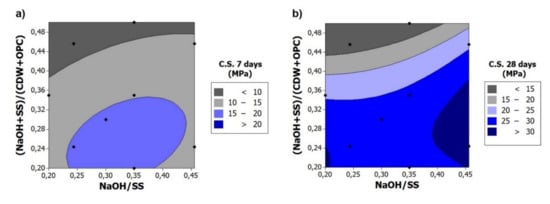
Figure 6.
Compressive strength (pastes) at 7 (a) and 28 (b) days of curing: effect of alkaline activator content and optimization of CDW-based hybrid cement (binder).
Figure 7 represents the evolution of the compressive strength of the optimal CDW binder (NaOH + SS/CDW + OPC = 0.35 and NaOH/SS = 0.34) as a function of curing time (1–90 days) of paste, compared to a reference paste based 100% on OPC. It can be seen how both pastes increase their strength with the evolution of the curing time; noting that, in general, the mechanical performance of the OPC paste is superior to the CDW paste. However, it should be underlined that this difference decreases between 7 and 90 days, a period in which the CDW paste showed a higher strength gain than the OPC paste. The lower compressive strength of CDW paste at an early age (1 and 7 days) is attributable to the low reactivity of the precursor due to its highly crystalline character, as shown in Figure 4. However, from 7 to 28 days, the compressive strength increases significantly (100%), which is attributed to the addition of OPC (10%) that allowed the hardening of the material at room temperature and also accelerated the formation of the alkaline reaction products (C–S–H, C–A–S–H or N,C–A–S–H). The maximum compressive strengths reported by CDW and OPC pastes at 90 days were 43.9 MPa and 49.3 MPa, respectively. These maximum strength values at 90 days (CDW paste = 43.9 MPa vs. OPC paste = 49.3 MPa) represent an increase of 397% and 138% in relation to the strength reported by CDW and OPC pastes at 1 day of curing (CDW paste = 8.8 MPa vs. OPC paste = 20.7 MPa), respectively. This behavior agrees with that reported by Mejia et al. [25], who obtained similar strength increases for an alkali-activated cement based on an FA–GBFS mixture, among other authors [26,27]. In relation to the above, the increase in the strength of hybrid cements is related to the densification of the matrix and the greater formation of “hydrated sodium-calcium aluminum silicates” or (N,C)–A–S–H and C–A–S–H type gels as the curing time increases [28,29].
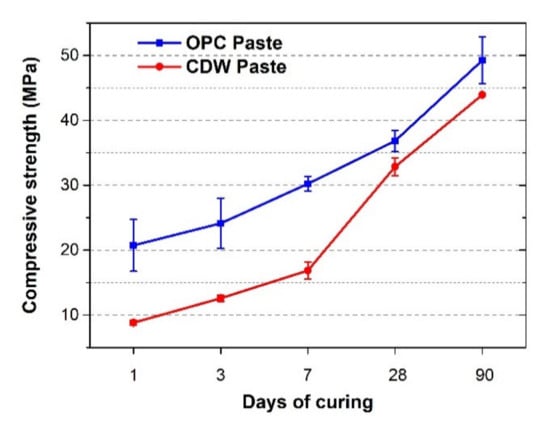
Figure 7.
Evolution of compressive strength of the CDW-based hybrid cement (optimal mix): comparison with a 100% OPC-based paste (reference mix).
It should be noted that this is the first time that results have been reported for alkali-activated materials based on a CDW precursor consisting of the mixture of concrete (25%), ceramic (25%), masonry (25%) and mortar (25%) wastes. Regarding the results reported in Table 1, which are related to alkali-activated materials produced from separated or “clean” wastes, it is highlighted that the maximum compressive strength achieved by the CDW binder (43.9 MPa) in this research exceeds the performance of most of these reports, as shown in Table 1. Additionally, the curing conditions of the CDW binder were at room temperature (≈25 °C and RH ≈ 80%), that is, no hydrothermal curing processes (50–90 °C) such as those indicated by other authors were necessary, as shown in Table 1. Likewise, it should be noted that the content of OPC added to the CDW binder was only 10% (by weight), lower than the content (≤40%) of addition or incorporation of calcium-rich materials (OPC, GBFS or Ca(OH)2) or alumino-silicates (FA or MK) previously reported, as shown in Table 1.
Figure 8 shows the results obtained by the calorimetric analysis of CDW paste (90%CDW + 10%OPC + NaOH-SS) compared to OPC paste (100% OPC + H2O) and a reference paste composed of the mixture 90%CDW + 10%OPC + H2O. In the case of CDW paste, the maximum peak was identified in the heat evolution curve, as shown in Figure 8, (left), in a reaction time of less than 10 min, reaching a maximum of 12.6 J/g of binder. In this regard, the appearance of a single high intensity peak on the heat evolution curve coincides with that reported by other authors [30,31,32,33] for alkali-activated cements based on MK, FA, GBFS, natural pozzolans, and/or their corresponding mixtures.
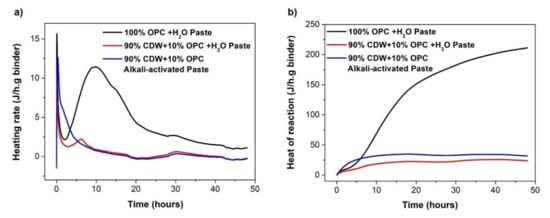
Figure 8.
Isothermal calorimetry: reaction kinetics of hybrid cement (binder) based on CDW (optimal mix). Evolution of heat of hydration (a) and total heat of hydration (48 h) (b).
Likewise, the maximum heat peak reported by the CDW paste (12.6 J/g of cement) was higher than that shown by the 90%CDW + 10%OPC+ H2O paste (10.4 J/g of cement); behavior that can be associated with the development of alkaline activation reactions in the CDW binder, in accordance with what was reported by Garcia-Lodeiro et al. [34]. Indeed, the total heat of reaction, as shown in Figure 8, (right) of the CDW paste (alkali-activated) and the 90%CDW + 10%OPC + H2O (hydrated) paste was 31.8 and 23.8 J/h∙g, respectively. This shows that the presence of the alkaline activator (NaOH + SS) in the CDW binder promotes a positive effect on the kinetics of the alkaline activation reactions for the 90%CDW+10%OPC mixture, exceeding the heat value by 33.6%, the value of total heat reported by the mixture without alkaline activator (90%CDW + 10%OPC + H2O paste). The OPC paste, meanwhile, showed the maximum heat peak in the first minutes, as shown in Figure 8, (left), among the pastes studied, with a value of 14.9 J/h∙g of cement. This value coincides with the maximum heat range (12.6–36.4 J/h∙g) reported by other authors for OPC-based pastes [35,36,37]. Using the total heat of hydration curve, as shown in Figure 8, (right), it was possible to observe that the CDW paste released a greater amount of heat during the first hours (≤5 h) compared to the OPC paste. However, this behavior was reversed after 5 h. In fact, the OPC paste released a total heat of hydration of up to 211.2 J/h∙g of cement; a value that exceeds the total heat reported by the CDW paste by 664.2% (31.8 J/h∙g).
Additionally, the initial and final setting times (ASTM C191) of the optimal CDW binder (NaOH + SS/CDW + OPC = 0.35 and NaOH/SS = 0.34) were determined, yielding values of 40 and 52 min, respectively. Likewise, standard mortars with a CDW/sand ratio of 1:2.75 were manufactured, which were subjected to the compressive strength test (ASTM C109) after 28 days of curing, reaching a strength value of 34.6 MPa.
Based on the specifications established by the ASTM C1157 standard, where the compressive strength is one of the most important parameters for the classification of cements based on their performance, the CDW-based hybrid cement obtained in this research could be classified as a general-use cement (GU type), because the mortar made with this binder attained a strength (34.6 MPa) higher than that required by ASTM C1157 (28 MPa). Additionally, based on the isothermal calorimetry results, CDW-based hybrid cement could also be classified as a low-heat-of-hydration cement (type LH) with a total heat of reaction of 31.8 J/g of cement, less than the maximum value required by the standard to achieve this classification (290 J/g of cement).
3.2. Characterization of CDW-Based Hybrid Concrete (AAHC) (As Both Precursor and Aggregates)
Figure 9 presents the internal appearance of the CDW-based AAHC compared to 100% OPC-based conventional concrete. This image highlights, in addition to the adequate (homogeneous) distribution of the CDW aggregates, the brown color of the AAHC. This phenomenon is due to the color of the CDW precursor, mainly due to ceramic waste (red) and masonry waste (red), as shown in Figure 2. In this regard, what in principle could be considered a disadvantage (a color other than the conventional “gray”), becomes an advantage at the application or industrial level. Currently, the demand and production of colored architectural concrete has shown an increase with the modernization of the construction industry [38], leaning on a technological level due to a particular interest in alternative pigments to minerals (waste), of low cost, with greater stability than conventional paints, and even obtaining colored concrete with reflective or thermally insulating properties (cool colored concretes) [39].
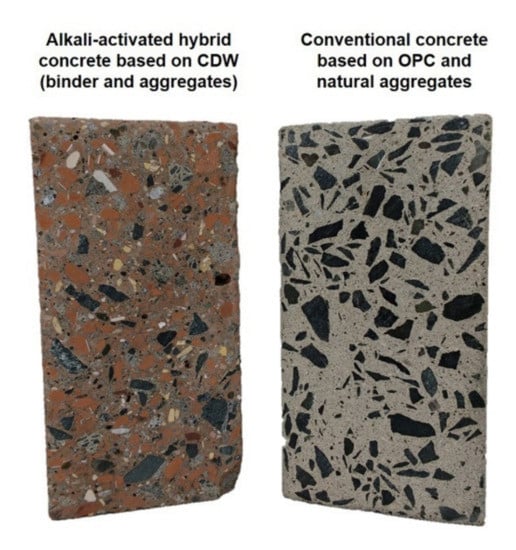
Figure 9.
Internal appearance and aggregate distribution of CDW-based hybrid concrete (AAHC) vs. OPC concrete.
The evolution of the compressive strength of the CDW-based AAHC is presented in Figure 10. The values of compressive strength at 1, 3, 7, 28, and 90 days were 8.5, 17.4, 20.5, 33.9, and 42.6 MPa, respectively. A progressive increase in mechanical performance with the course of curing time stands out; this being an increase of 403% considering the values reported between days 1 (8.5 MPa) and 90 (42.6 MPa). Considering the strength limit (17.5 MPa) established by ACI 318 (red line), the CDW–based AAHC reaches its structural classification after 7 days of curing; noting that the CDW-based AAHC curing process was at room temperature (≈25 °C) and under humid conditions (relative humidity (RH) ≈80%) and not under immersion in water as established for OPC-based concretes. Meanwhile, the splitting tensile strength (ASTM C496) of the CDW-based AAHC at 28 days of curing was 3.0 MPa; a value that represents 8.9% of its compressive strength (33.9 MPa) at this same age.

Figure 10.
Evolution of compressive strength (≈25 °C) of CDW-based hybrid concrete (AAHC).
It should be noted that, contrary to the studies reported by other authors, as shown in Table 1, in the field of CDW-based alkali-activated materials (pastes and mortars), the results presented here correspond to the level of concrete. In this sense, and despite the fact that it is not considered correct to compare these results with determined values for pastes and mortars, the level of compressive strength (up to 42.60 MPa at 90 days) reached by the CDW-based AAHC stands out, as shown in Figure 10, highlighting its curing at room temperature (≈25 °C), that is, the non-dependence on additional hydrothermal curing processes. Likewise, the results of compressive strength (28 days) obtained at the level of paste (32.9 MPa), mortar (34.6 MPa), and concrete (33.9 MPa) highlight the binding capacity of the CDW binder, managing to maintain the same resistant level (32–35 MPa) despite the presence of fine aggregates (FRA) and/or coarse recycled (CRA) in the mixture.
Figure 11 represents the SEM-EDS microstructural analysis of the CDW-based AAHC at 28 days of curing. Through this technique it was possible to study the elemental chemical composition found for AAHC at the microstructural level and thus obtain a graphic representation in a SiO2-Al2O3-CaO ternary diagram of the results obtained, as shown in Figure 11.
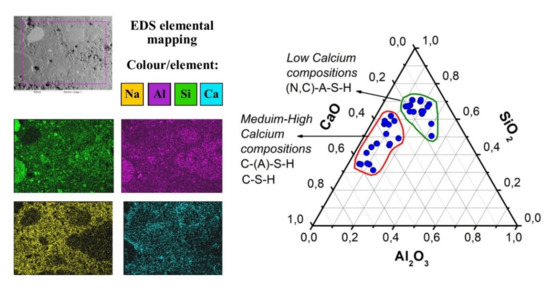
Figure 11.
SEM-EDS microstructural analysis (28 days of curing) of AAHC binder.
This ternary diagram represents a total of 35 EDS points analyzed on the AAHC binder. The results obtained are grouped into the regions of “low calcium compositions” and “medium-high calcium compositions”. Some authors have managed to correlate these representative areas of the SiO2–Al2O3–CaO ternary diagram with (N,C)–A–S–H (poor in Ca2+), C–S–H, and C–A–S–H type (rich in Ca2+) reaction products for alkali-activated materials and hybrid cements based on other precursors, such as FA, GBFS, and/or natural pozzolans [29,40,41,42,43,44,45]. An EDS elementary color mapping performed on a specific area of the AAHC, as shown in Figure 11, showed the homogeneous distribution of silica (Si: green), alumina (Al: purple), sodium (Na: yellow), and calcium (Ca: turquoise) in the concrete, distinguishing the CDW aggregates (poor areas in Na) from the CDW binder (areas rich in Si, Al, Na, and Ca).
In addition, the microstructural observation of the AAHC, as shown in Figure 12, demonstrates the obtaining of a homogeneous interface transition zone between the CDW binder and the fine (FRA) and coarse (CRA) aggregates based on CDW, which agrees with the high mechanical performance reported for this material.
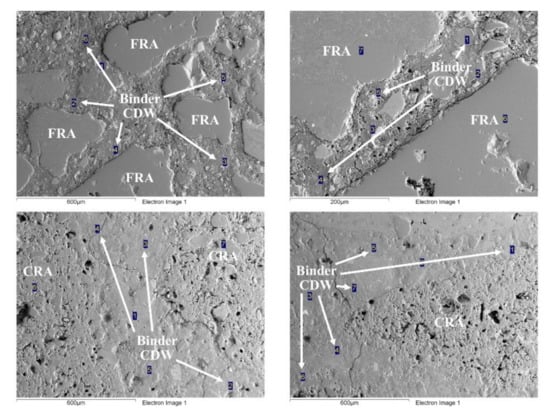
Figure 12.
SEM microstructural observation (28 days of curing) of CDW-based hybrid concrete (AAHC).
The mechanical and microstructural results validate the possibility of using alkaline activation technology to obtain structural concretes based on fully utilizing CDW (binder + aggregates).
3.3. Production and Characterization of a Building Element (Solid Block Type) from the AAHC
Solid concrete blocks were produced from the AAHC, which were physically and mechanically characterized according to the specifications set out by ASTM C140. Table 5 presents the properties and characteristics of the solid block, which highlights the achievement of a compressive strength at 28 days of 26.1 MPa; a value that exceeds the established lower limit of strength (13 MPa) by 101%. According to ASTM C90 (equivalent to NTC 4026) is classified as “high class structural block”. For comparative purposes, the ASTM C1790 standard establishes, in the case of blocks based on the alkaline activation of “fly ash”, that the compressive strength must be greater than 24.1 MPa. According to NTC 4026, the maximum percentage of water absorption allowed for medium-weight blocks (1680–2000 kg/m3) is 15%; a condition that the CDW block meets, with water absorption at 14.4%. It should be noted that the ASTM C140 standard establishes that these limits of water absorption and compressive strength must be met within 12 months after the units are produced. The results obtained (28 days) allowed us to validate the potential use of the CDW-based AAHC in structural precast products suitable for construction applications.

Table 5.
Properties and characteristics of the solid block made from CDW-based hybrid concrete (AAHC).
4. Conclusions
The results of this research demonstrate the possibility of producing alkali-activated materials (pastes, mortars, concrete, and precast building elements) based on the mixture of concrete, ceramic, masonry and mortar wastes as a sustainable alternative for the recycling of construction and demolition wastes (CDWs). It should be noted that CDWs were used to obtain both binder and aggregates (fine and coarse), thus achieving a comprehensive application of CDWs. The following conclusions can be drawn from the experimental results.
Alkaline activation of the CDW precursor, using mixtures of hydroxide and sodium silicate, allowed the synthesis of a CDW binder with compressive strengths of up to 43.9 MPa after 90 days of curing at room temperature. In this context, the addition of only 10% OPC allowed the mixtures to cure at room temperature (≈25 °C). The compressive strength achieved by the CDW binder-based mortar was 34.6 MPa. The total heat of reaction of this hybrid cement reached maximum values of 31.8 J/h∙g. Based on mechanical performance and total heat of reaction, the CDW binder can be classified as general-use cement (GU type) and low heat of hydration (LH type), meeting the specifications of ASTM C1157.
The CDW concrete achieved compressive strength values of up to 42.6 MPa (90 days of curing (≈25 °C)), demonstrating the possibility of obtaining structural classification concretes according to ACI 318 specifications. The compressive and splitting tensile strengths of CDW concrete were 33.9 and 3.0 MPa, respectively (28 days of curing). Based on the results obtained at the levels of paste (32.9 MPa), mortar (34.6 MPa) and concrete (33.9 MPa), the binding capacity of the CDW binder was demonstrated, managing to maintain the same strength level (32–35 MPa) despite the presence of recycled aggregates (fine and/or coarse). These results further demonstrated that recycled aggregates do not affect the mechanical performance of alkali-activated materials. The SEM-EDS micro-structural analysis carried out on the CDW concrete demonstrated the formation, in the binder phase, of (N,C)-A-S-H (poor in Ca2+), C-S-H, and C-A-S-H (rich in Ca2+) type reaction products, in addition to homogeneous interfacial transition zones, which taken together is consistent with the high mechanical performances reported for alkali-activated materials.
The production and physical-mechanical characterization of a solid concrete block demonstrated the application potential of CDW concrete in the production of precast building elements. This CDW concrete block (1925.8 kg/m3) reported a compressive strength of 26.1 MPa (28 days), exceeding by 101% the lower strength limit (13 MPa) established by the ASTM C90 standard to be classified as a “high class structural block”.
The reported results validate the possibility of using alkaline-activation technology in obtaining alkali-activated materials based on making the fullest use of CDWs (binder + aggregates). This innovative recycling concept is considered a sustainable alternative for the real-life use of CDWs in conditions where the separation of concrete, ceramic, masonry, and mortar wastes is not possible. Furthermore, these results validate the possibility of reusing CDWs to obtain new materials with greater commercial value (cements and building applications) than recycled aggregates (common use;, an advantage that would promote the proper handling and management of this type of waste in the construction sector, towards the goal of “zero waste”, complying with the basic principles of the circular economy.
Author Contributions
Conceptualization, R.A.R.-S., W.V.-S., and R.M.d.G.; methodology and investigation, R.A.R.-S. and W.V.-S.; writing—original draft preparation, R.A.R.-S. and W.V.-S.; supervision, writing—review and editing, project administration, R.M.d.G. All authors have read and agreed to the published version of the manuscript.
Funding
This research was funded by Colombian Institute for the Development of Science, Technology, and Innovation (Colciencias), grant number 096-2016 and the Universidad del Valle (Cali, Colombia), grant number CI-21025.
Acknowledgments
R. Robayo-Salazar and W. Valencia-Saavedra thanks the call No. 848-2019 (Minciencias) for the postdoctoral fellowship in Colombia.
Conflicts of Interest
The authors declare no conflict of interest.
References
- European Commission, Construction and Demolition Waste (CDW). 2016. Available online: http://ec.europa.eu/environment/waste/construction_demolition.htm (accessed on 13 March 2018).
- Akhtar, A.; Sarmah, A.K. Construction and demolition waste generation and properties of recycled aggregate concrete: A global perspective. J. Clean. Prod. 2018, 186, 262–281. [Google Scholar] [CrossRef]
- Naciones Unidas CEPAL, Agenda 2030 y los Objetivos de Desarrollo Sostenible. Una oportunidad Para America Latina y el Caribe. Available online: http://www.sela.org/media/2262361/agenda-2030-y-los-objetivos-de-desarrollo-sostenible.pdf (accessed on 18 January 2018).
- Akcil, A.; Agcasulu, I.; Swain, B. Valorization of waste LCD and recovery of critical raw material for circular economy: A review. Resour. Conserv. Recycl. 2019, 149, 622–637. [Google Scholar] [CrossRef]
- Tam, V.W.Y.; Soomro, M.; Evangelista, A.C.J. A review of recycled aggregate in concrete applications (2000–2017). Constr. Build. Mater. 2018, 172, 272–292. [Google Scholar] [CrossRef]
- Vieira, C.S.; Pereira, P.M. Use of recycled construction and demolition materials in geotechnical applications: A review. Resour. Conserv. Recycl. 2015, 103, 192–204. [Google Scholar] [CrossRef]
- Wu, Y.; Lu, B.; Bai, T.; Wang, H.; Du, F.; Zhang, Y.; Cai, L.; Jiang, C.; Wang, W. Geopolymer, green alkali activated cementitious material: Synthesis, applications and challenges. Constr. Build. Mater. 2019, 224, 930–949. [Google Scholar] [CrossRef]
- RILEM Technical Committee 247-DTA, 247-DTA: Durability Testing of Alkali-Activated Materials. Available online: https://www.rilem.net/groupe/247-dta-durability-testing-of-alkali-activated-materials-290 (accessed on 18 January 2018).
- Lampris, C.; Lupo, R.; Cheeseman, C. Geopolymerisation of silt generated from construction and demolition waste washing plants. Waste Manag. 2009, 29, 368–373. [Google Scholar] [CrossRef]
- Reig, L.; Tashima, M.; Borrachero, M.; Monzó, J.; Cheeseman, C.; Payá, J. Properties and microstructure of alkali-activated red clay brick waste. Constr. Build. Mater. 2013, 43, 98–106. [Google Scholar] [CrossRef]
- Komnitsas, K.; Zaharaki, D.; Vlachou, A.; Bartzas, G.; Galetakis, M. Effect of synthesis parameters on the quality of construction and demolition wastes (CDW) geopolymers. Adv. Powder Technol. 2015, 26, 368–376. [Google Scholar] [CrossRef]
- Robayo, R.A.; Mulford, A.; Munera, J.; De Gutiérrez, R.M. Alternative cements based on alkali-activated red clay brick waste. Constr. Build. Mater. 2016, 128, 163–169. [Google Scholar] [CrossRef]
- Vásquez, A.; Cárdenas, V.; Robayo, R.A.; De Gutiérrez, R.M. Geopolymer based on concrete demolition waste. Adv. Powder Technol. 2016, 27, 1173–1179. [Google Scholar] [CrossRef]
- Zaharaki, D.; Galetakis, M.; Komnitsas, K. Valorization of construction and demolition (C&D) and industrial wastes through alkali activation. Constr. Build. Mater. 2016, 121, 686–693. [Google Scholar] [CrossRef]
- Sassoni, E.; Pahlavan, P.; Franzoni, E.; Bignozzi, M.C. Valorization of brick waste by alkali-activation: A study on the possible use for masonry repointing. Ceram. Int. 2016, 42, 14685–14694. [Google Scholar] [CrossRef]
- Murillo, L.M.; Delvasto, S.; Suárez, M.G. A study of a hybrid binder based on alkali-activated ceramic tile wastes and portland cement. In Sustainable and Nonconventional Construction Materials Using Inorganic Bonded Fiber Composites; Elsevier BV: Amsterdam, The Netherlands, 2017; pp. 291–311. [Google Scholar]
- Reig, L.; Sanz, M.; Borrachero, M.; Monzó, J.; Soriano, L.; Payá, J. Compressive strength and microstructure of alkali-activated mortars with high ceramic waste content. Ceram. Int. 2017, 43, 13622–13634. [Google Scholar] [CrossRef]
- Robayo-Salazar, R.; Rivera, J.F.; De Gutiérrez, R.M. Alkali-activated building materials made with recycled construction and demolition wastes. Constr. Build. Mater. 2017, 149, 130–138. [Google Scholar] [CrossRef]
- Tuyan, M.; Andiç-Çakir, Ö.; Ramyar, K. Effect of alkali activator concentration and curing condition on strength and microstructure of waste clay brick powder-based geopolymer. Compos. Part B Eng. 2018, 135, 242–252. [Google Scholar] [CrossRef]
- Fort, J.; Vejmelková, E.; Koňáková, D.; Alblová, N.; Čáchová, M.; Keppert, M.; Rovnaníková, P.; Černý, R. Application of waste brick powder in alkali activated aluminosilicates: Functional and environmental aspects. J. Clean. Prod. 2018, 194, 714–725. [Google Scholar] [CrossRef]
- Hwang, C.-L.; Yehualaw, M.D.; Vo, D.-H.; Huynh, T.-P. Development of high-strength alkali-activated pastes containing high volumes of waste brick and ceramic powders. Constr. Build. Mater. 2019, 218, 519–529. [Google Scholar] [CrossRef]
- Olivia, M.; Nikraz, H. Properties of fly ash geopolymer concrete designed by Taguchi method. Mater. Des. 2012, 36, 191–198. [Google Scholar] [CrossRef]
- Reig, L.; Soriano, L.; Borrachero, M.; Monzó, J.; Payá, J. Influence of the activator concentration and calcium hydroxide addition on the properties of alkali-activated porcelain stoneware. Constr. Build. Mater. 2014, 63, 214–222. [Google Scholar] [CrossRef]
- Puertas, F.; Barba, A.; Gazulla, M.F.; Gómez, M.P.; Palacios, M.; Martinez-Ramirez, S. Residuos cerámicos para su posible uso como materia prima en la fabricación de clínker de cemento Portland: Caracterización y activación alcalina. Mater. Constr. 2006, 56, 73–84. [Google Scholar] [CrossRef]
- De Gutiérrez, R.M.; Mejía, J.M.; Puertas, F. Ceniza de cascarilla de arroz como fuente de sílice en sistemas cementicios de ceniza volante y escoria activados alcalinamente. Mater. Constr. 2013, 63, 361–375. [Google Scholar] [CrossRef]
- Puertas, F.; Martínez-Ramírez, S.; Alonso, S.; Vázquez, T. Alkali-activated fly ash/slag cements. Cem. Concr. Res. 2000, 30, 1625–1632. [Google Scholar] [CrossRef]
- Phoo-Ngernkham, T.; Chindaprasirt, P.; Sata, V.; Pangdaeng, S.; Sinsiri, T. Properties of high calcium fly ash geopolymer pastes with Portland cement as an additive. Int. J. Miner. Met. Mater. 2013, 20, 214–220. [Google Scholar] [CrossRef]
- Rivera, J.F.; Mejia, J.M.; De Gutiérrez, R.M.; Suárez, M.G. Hybrid cement based on the alkali activation of by-products of coal. Rev. Constr. 2014, 13, 31–39. [Google Scholar] [CrossRef]
- Garcia-Lodeiro, I.; Fernández-Jiménez, A.; Palomo, A. Variation in hybrid cements over time. Alkaline activation of fly ash–portland cement blends. Cem. Concr. Res. 2013, 52, 112–122. [Google Scholar] [CrossRef]
- Bernal, S.A.; Rodriguez, E.D.; De Gutiérrez, R.M.; Provis, J.L.; Delvasto, S. Activation of Metakaolin/Slag Blends Using Alkaline Solutions Based on Chemically Modified Silica Fume and Rice Husk Ash. Waste Biomass Valoriz. 2011, 3, 99–108. [Google Scholar] [CrossRef]
- Mejia, J.; Rodriguez, E.D.; De Gutiérrez, R.M. Utilización potencial de una ceniza volante de baja calidad como fuente de aluminosilicatos en la producción de geopolímeros. Ing. Univ. 2014, 18, 309. [Google Scholar] [CrossRef]
- De Gutiérrez, R.M.; Robayo, R.A.; Gordillo, M. Natural pozzolan—And granulated blast furnace slag-based binary geopolymers. Mater. Constr. 2016, 66. [Google Scholar] [CrossRef]
- Robayo-Salazar, R.; De Gutiérrez, R.M.; Puertas, F. Study of synergy between a natural volcanic pozzolan and a granulated blast furnace slag in the production of geopolymeric pastes and mortars. Constr. Build. Mater. 2017, 157, 151–160. [Google Scholar] [CrossRef]
- Lodeiro, I.G.; Fernandez-Jiménez, A.; Palomo, A. Hydration kinetics in hybrid binders: Early reaction stages. Cem. Concr. Compos. 2013, 39, 82–92. [Google Scholar] [CrossRef]
- Gruyaert, E.; Robeyst, N.; De Belie, N. Study of the hydration of Portland cement blended with blast-furnace slag by calorimetry and thermogravimetry. J. Therm. Anal. Calorim. 2010, 102, 941–951. [Google Scholar] [CrossRef]
- Xu, H.; Gong, W.; Syltebo, L.; Lutze, W.; Pegg, I.L. DuraLith geopolymer waste form for Hanford secondary waste: Correlating setting behavior to hydration heat evolution. J. Hazard. Mater. 2014, 278, 34–39. [Google Scholar] [CrossRef] [PubMed]
- Xu, Q.; Hu, J.; Ruiz, J.M.; Wang, K.; Ge, Z. Isothermal calorimetry tests and modeling of cement hydration parameters. Thermochim. Acta 2010, 499, 91–99. [Google Scholar] [CrossRef]
- López, A.; Guzmán, G.A.; Di Sarli, A.R. Color stability in mortars and concretes. Part 2: Study on architectural concretes. Constr. Build. Mater. 2016, 123, 248–253. [Google Scholar] [CrossRef]
- Levinson, R.; Akbari, H.; Berdahl, P.; Wood, K.; Skilton, W.; Petersheim, J. A novel technique for the production of cool colored concrete tile and asphalt shingle roofing products. Sol. Energy Mater. Sol. Cells 2010, 94, 946–954. [Google Scholar] [CrossRef]
- Ortega, E.A.; Cheeseman, C.; Knight, J.; Loizidou, M. Properties of alkali-activated clinoptilolite. Cem. Concr. Res. 2000, 30, 1641–1646. [Google Scholar] [CrossRef]
- Lodeiro, I.G.; Macphee, D.; Palomo, A.; Fernandez-Jiménez, A. Effect of alkalis on fresh C–S–H gels. FTIR analysis. Cem. Concr. Res. 2009, 39, 147–153. [Google Scholar] [CrossRef]
- Gebregziabiher, B.S.; Thomas, R.J.; Peethamparan, S. Temperature and activator effect on early—Age reaction kinetics of alkali-activated slag binders. Constr. Build. Mater. 2016, 113, 783–793. [Google Scholar] [CrossRef]
- Herrero, M.J.S.; Fernandez-Jiménez, A.; Palomo, A. Alkaline Hydration of C2S and C3S. J. Am. Ceram. Soc. 2015, 99, 604–611. [Google Scholar] [CrossRef]
- Djobo, J.N.Y.; Tchakouté, H.K.; Ranjbar, N.; Elimbi, A.; Tchadjié, L.N.; Njopwouo, D. Gel Composition and Strength Properties of Alkali-Activated Oyster Shell-Volcanic Ash: Effect of Synthesis Conditions. J. Am. Ceram. Soc. 2016, 99, 3159–3166. [Google Scholar] [CrossRef]
- Robayo-Salazar, R.; De Gutiérrez, R.M.; Puertas, F. Alkali-activated binary concrete based on a natural pozzolan: Physical, mechanical and microstructural characterization. Mater. Constr. 2019, 69, 191. [Google Scholar] [CrossRef]
© 2020 by the authors. Licensee MDPI, Basel, Switzerland. This article is an open access article distributed under the terms and conditions of the Creative Commons Attribution (CC BY) license (http://creativecommons.org/licenses/by/4.0/).
